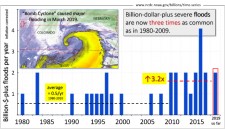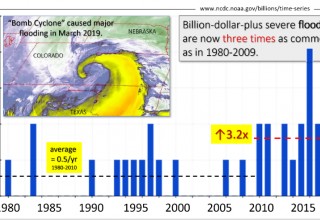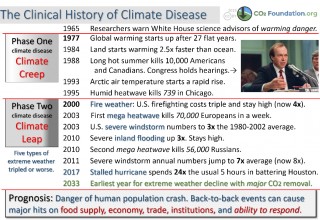
2019's record Midwestern flooding and current New Orleans high water have roots in a combination of warmer Gulf of Mexico waters in the south and longer, slower jet stream loops from Arctic warming in the north.
SEATTLE, July 14, 2019 (Newswire.com) - There are at least two reasons why more rain arrives from the Gulf of Mexico these days. The surface temperature of the ocean has been rising since 1977, making more water evaporate, creating extra humidity that the winds carry ashore, to be made into rain. “That affects the South, Midwest, and the Great Plains states up to Nebraska,” explains Dr. William H. Calvin, president of the CO2 Foundation in Seattle.
“I grew up in Kansas City and wondered where all of that summer humidity came from, as we didn’t have any big lakes nearby, the way Chicago does,” he said. “Now I know—it came from the Gulf of Mexico, 700 miles to the south. Our hot air was rising, pulling in surface air from all directions.” And thanks to the 45 percent excess of CO2, the Gulf is now overproducing humidity.
“Most of our extreme weather occurs in the same east-of-the-Rockies states as the Gulf of Mexico influences. You’d think those states would be leading the charge to fix extreme weather,” he observes. “Not yet.”
The second reason that rains have become worse is that a hurricane will sometimes stall in its ground track, so that the rain cannot spread out over a broad area. “Hurricane Harvey in 2017 would have passed over Houston in five hours if not for a jet-stream blocking event. It lingered for five days instead, 24 times longer, dumping a year’s worth of rain atop all of the storm surge.” But it is not only blocking; it seems that the south-to-north “steering winds” have slowed down as well, thanks to Arctic warming. Last year, a downpour kept dumping rain on southern Japan for more than two weeks.
NOAA has been tracking billion-dollar floods each year in the U.S. In the 30 years before 2010, once corrected for inflation, such an inland flood occurred every other year. “But since 2010, we are averaging three times as many each year. And that doesn’t include the sea surge flooding from hurricanes pushing seawater ashore.”
It is not only the number of billion-dollar floods each year, he says; a similar jump in severity or numbers can be seen for four other types of extreme weather. Most are worse than triple. “Billion-dollar windstorms are now eight times as common as they used to be before 2003. And to judge from firefighting costs, ‘fire weather’ tripled in 2000. Now it is four times the 1990s numbers.”
Then there are the mega heat waves in Europe in 2003 and in Russia in 2010 that each killed about a hundred times more people in a week than did 20th-century heat waves. “Most share a common mechanism: weather stalled by a long jet-stream meander,” Dr. Calvin points out.
“In retrospect,” Dr. Calvin says, “we had an abrupt climate shift back then. Climate change was not gradual, the way we had assumed it would be. Starting fifty years ago, climate scientists repeatedly warned that extreme weather would get worse. But predicting a large-scale climate flip is far more difficult.” The cumulative effects of the rapid Arctic warming that began in 1993 has produced more of those troublesome jet stream loops. “The Arctic has a vicious cycle we must break,” he said. “It responds to a warmer day by absorbing even more warmth the following day. And on and on. Then, half a world away, minor problems become major problems.”
At the CO2 Foundation, he said, “We describe extreme weather as the major player, not the next creep up in global average surface temperature. And we try looking at it with the mindset of emergency medicine physicians. At the CO2 Foundation we are developing plans for a ‘Manhattan Project 2.0’ to design and prototype our way out of this mess, cleaning up the excess CO2 overhead.”
William H. Calvin, Ph.D., is an emeritus professor at the University of Washington School of Medicine in Seattle and the author of Global Fever. He wrote the first cover story on climate instability, “The Great Climate Flip-Flop,” for The Atlantic in 1998. He is also the president of CO2Foundation.org, which is busy trying to educate policymakers and the public about extreme weather threats and the need to quickly draw down the 45% excess of CO2 overhead. His email is WCalvin@UW.edu.
The CO2 Foundation educates the public about the latest climate science and carbon sequestration approaches, made more urgent by the ongoing extreme weather crisis. We focus especially on building awareness of less-understood carbon dioxide removal and other climate restoration strategies urgently needed alongside emissions reductions. Our mission also includes highlighting values-based resilience practices, prioritizing climate justice, and creating space for climate conversations and learning among all population sectors.
Source: The billion-$ data is curated at www.ncdc.noaa.gov/billions/time-series.
D. Coumou et al. (2018). The Influence of Arctic Amplification on Mid-latitude Summer Circulation. Nature Communications 9, 2959.
James P. Kossin (2018). A global slowdown of tropical-cyclone translation speed. Nature 558:104–107. [for 11 mph ground speed]
Michael E. Mann et al. (2017). Influence of Anthropogenic Climate Change on Planetary Wave Resonance and Extreme Weather Events. Scientific Reports 7, 45242
Michael E. Mann et al. (2018). Projected Changes in Persistent Extreme Summer Weather Events: The Role of QuasiResonant Amplification. Science Advances 4, eaat3272.
Source: CO2 Foundation
Share:




